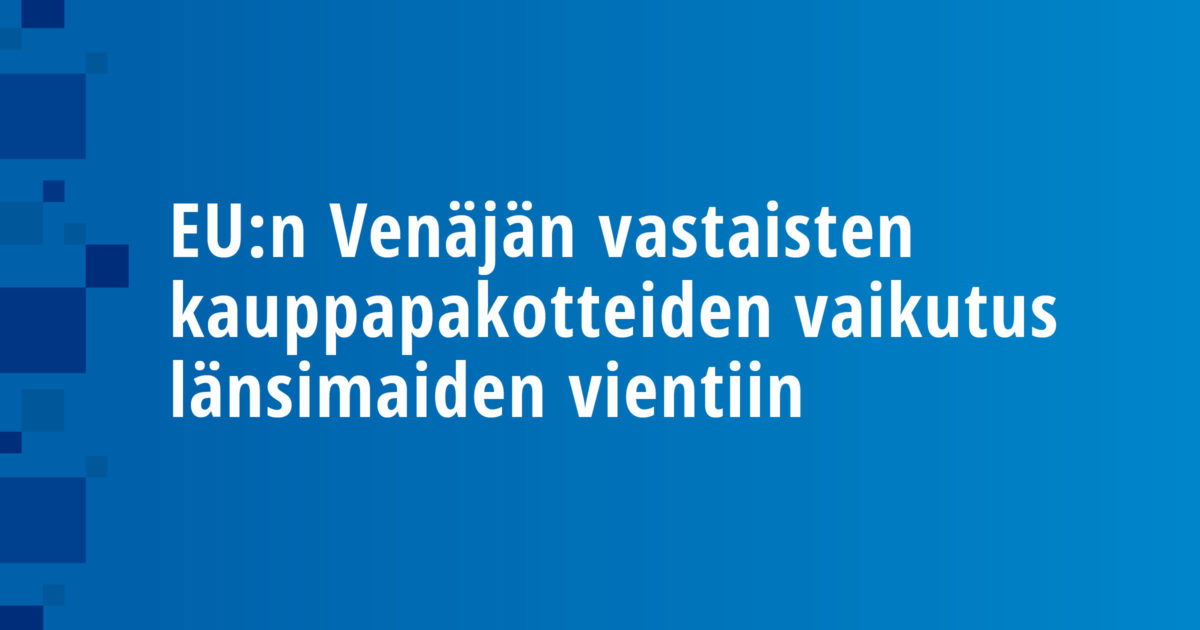
EU:n Ukrainan kriisin takia asettamat kauppapakotteet astuivat voimaan 1.8.2014. Pakotteiden alaisia tuotteita vietiin Venäjälle 22 miljardin euron arvosta vuosina 2001–2017. Tärkeimmät viejämaat olivat Ukraina, Kiina, Etelä-Korea, Saksa ja Yhdysvallat. Yleensä eri maiden vientiluvut ovat erittäin korkeat yksittäisinä vuosina ja muina vuosina hyvin pienet. Tuotteita vietiin vielä vuosina 2015–2017 2,2 miljardin euron arvosta, koska ennen 1.8.2014 tehdyt vientisopimukset ovat voimassa ja sensitiivisen teknologian vientikielto koskee vain tuotteita, joiden loppukohteet ovat kielletyt öljyalan projektit.
Koko maailman pakotteiden alaisten tuotteiden vienti Venäjälle putosi tuntuvasti vuonna 2015 edellisvuoden 1,6 miljardista eurosta 0,7 miljardiin euroon, mikä vastasi vuoden 2005 tasoa. Suomi vei vuosina 2001–2017 pakotteiden alaisia tuotteita 0,57 miljardin euron arvosta. Vuosina 2010–2011 oli poikkeuksellisen suuria 0,2 miljardin euron arvoisia toimituksia. Tämä vastasi 6,6 prosentin osuutta Venäjän viennistämme vuonna 2010, koko maailman vastaava osuus oli prosentti. Muina vuosina ennen pakotteita Suomen prosenttiosuus on ollut merkittävästi pienempi kuin koko maailman osuus keskimäärin, ja niiden asettamisen jälkeen Suomen pudotus on ollut pienempi. Suomi on siten kärsinyt vähemmän kauppapakotteista kuin muu maailma keskimäärin.
EU’s trade sanctions against Russia came into force 1.8.2014. Sanctioned products were exported to Russia at a value of 22 billion euros during the time period 2001–2017. The most important exporting countries were Ukraine, China, South Korea, Germany and the United States. Exports of banned products from a country to Russia may be very high in some years and very small in other years. Some products have been exported even during the years 2015–2017 at a value of 2,2 billion euros because export contracts which were made before 1.8.2014 are still in force and the ban on exports of sensitive technology concerns only products, the destination of which is forbidden projects in the oil sector.
The exports of the sanctioned products from the whole world to Russia fell substantially in the year 2015 from 1,6 billion euros in the previous year to 0,7 billion euros, which corresponded to the level in 2005. Finland exported banned products to Russia during the years 2001–2017 at a value of 0,57 billion euros. In the years 2010–2011, there were exceptionally big deliveries at a value of 0,2 billion euros. In relation to our total export of goods to Russia, this accounted for a share of 6,6 percent in the year 2010, the corresponding share for the whole world was one percent. In the other years before the sanctions, Finland’s percentage share has been substantially smaller than the average share of the whole world and after they have been imposed Finland’s share has fallen less than in other countries. We draw the conclusion that Finland has suffered less from the trade sanctions than the rest of the world on average.
Arkadiankatu 23 B
00100 HELSINKI
Vaihde ja vastaanotto avoinna arkisin klo 8.30–15:30.
+358 (09) 609 900